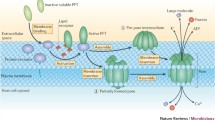Abstract.
Pore-forming toxins (PFTs) are the most common class of bacterial protein toxins and constitute important bacterial virulence factors. The mode of action of PFT is starting to be better understood. In contrast, little is known about the cellular response to this threat. Recent studies reveal that cells do not just swell and lyse, but are able to sense and react to pore formation, mount a defense, even repair the damaged membrane and thus survive. These responses involve a variety of signal-transduction pathways and sophisticated cellular mechanisms such as the pathway regulating lipid metabolism. In this review we discuss the different classes of bacterial PFTs and their modes of action, and provide examples of how the different bacteria use PFTs. Finally, we address the more recent field dealing with the eukaryotic cell response to PFT-induced damage.
Similar content being viewed by others
Author information
Authors and Affiliations
Corresponding author
Additional information
Received 19 September 2007; received after revision 18 October 2007; accepted 23 October 2007
Rights and permissions
About this article
Cite this article
Gonzalez, M.R., Bischofberger, M., Pernot, L. et al. Bacterial pore-forming toxins: The (w)hole story?. Cell. Mol. Life Sci. 65, 493–507 (2008). https://doi.org/10.1007/s00018-007-7434-y
Published:
Issue Date:
DOI: https://doi.org/10.1007/s00018-007-7434-y




